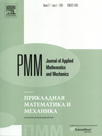 | | Journal of Applied
Mathematics and Mechanics
Russian Academy of Sciences | | Founded
in January 1936
(Translated from 1958)
Issued 6 times a year
ISSN 0021-8928
(print version) |
Archive of Issues
| Total articles in the database: | | 10610 |
| In Russian (ΟΜΜ): | | 9811
|
| In English (J. Appl. Math. Mech.): | | 799 |
|
| << Previous article | Volume 75, Issue 6 / 2011 | Next article >> |
| Kh.F. Valiyev and A.N. Kraiko, "Self-similar time-varying flows of an ideal gas with a change in the adiabatic exponent in a "reflected" shock wave," J. Appl. Math. Mech. 75 (6), 675-690 (2011) |
| Year |
2011 |
Volume |
75 |
Issue |
6 |
Pages |
675-690 |
| Title |
Self-similar time-varying flows of an ideal gas with a change in the adiabatic exponent in a "reflected" shock wave |
| Author(s) |
Kh.F. Valiyev (Moscow, Russia)
A.N. Kraiko (Moscow, Russia, akraiko@ciam.ru) |
| Abstract |
Self-similar one-dimensional time-varying problems are considered under the assumption that there is a change in the adiabatic exponent in a shock wave (SW) running ("reflected") from a centre or axis of symmetry (later from a centre of symmetry, CS) or from a plane. The medium is an ideal (inviscid and non-heat-conducting) perfect gas with constant heat capacities. In problems with strong SW, the change in the adiabatic exponent in a gas approximately simulates physicochemical processes such as dissociation and ionization and, in the problem of the collapse of a spherical cavity in a liquid, the conversion of liquid into vapour. In both cases, the adiabatic exponent decreases on passing across a reflected SW. Problems of the collapse of a spherical cavity, the reflection of a strong SW from a centre of symmetry and a simpler problem with a self-similarity index of one are examined. When it is assumed that there is an increase in the adiabatic exponent, the self-similar solutions of the first two problems are rejected due to the decrease in entropy from the instant when the SW is reflected. When it is assumed that there is a decrease in the adiabatic exponent, the solutions of these problems only become unsuitable after a finite time has elapsed for the same reason. Up to this time when the decrease in the adiabatic exponent has not reached a certain threshold, the structure of the self-similar solution does not undergo qualitative changes. When the above-mentioned threshold is exceeded, a self-similar solution is possible if a cylindrical or spherical piston expands according to a special law from the instant of SW reflection from the CS. When there is no piston, the flow behind the reflected wave becomes non-self- similar. In the case of the deceleration of a plane flow, conditions are possible with the joining of SW from different sides to a centred rarefaction wave. |
| Received |
31 March 2011 |
| Link to Fulltext |
|
| << Previous article | Volume 75, Issue 6 / 2011 | Next article >> |
|
 If you find a misprint on a webpage, please help us correct it promptly - just highlight and press Ctrl+Enter If you find a misprint on a webpage, please help us correct it promptly - just highlight and press Ctrl+Enter
|
|

 Russian
Russian  English
English